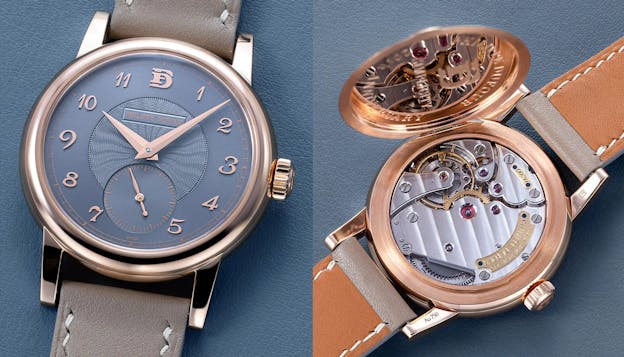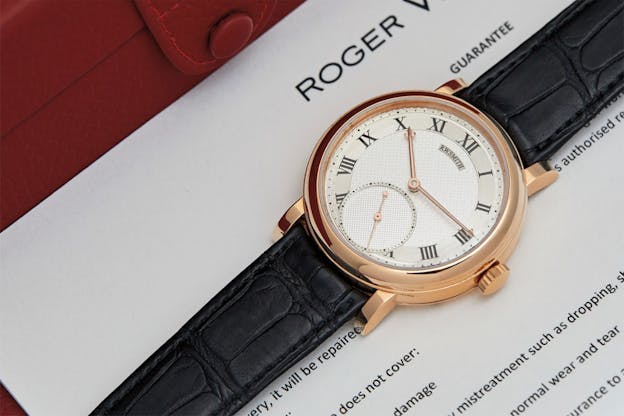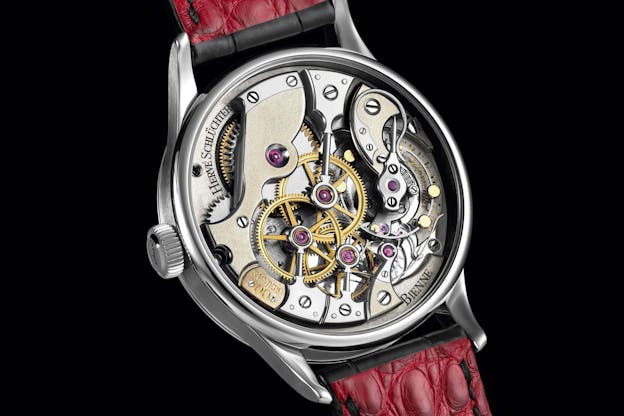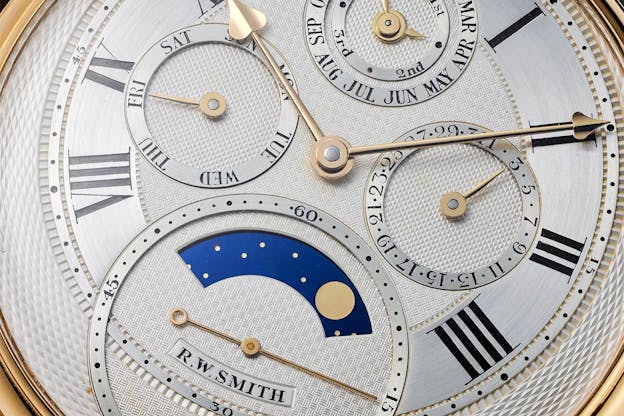How Independent Watchmaking’s Simplest Watches Became Its Most Exclusive
And why some of the simplest watches in the world are among the most expensive.
As a general rule, for as long as people have been making watches and clocks, there has been a simple relationship between complexity and price. The more complicated a watch was, the bigger the price tag, and the only caveat to that was that smaller a lot of the time meant more expensive, since miniaturization (especially of complications) took exponentially more care and skill. I remember looking at an old Audemars Piguet catalogue during a visit to the museum years ago and a ladies’ size minute repeater was two or three times more costly thanks to the extra labor required to make the movement.
Today, however, we have a very interesting situation in that almost the opposite seems to be true. Some of the most desirable and most expensive wristwatches anyone is making are also the simplest – time-only, or at most, time-only with small complications like a day and night indication, or up and down work (power reserve). Prices for such watches if bought new from their maker can easily reach into the six figures. In 2021, the New York Times reported that one of the most widely respected independent watchmakers, Roger Smith, was pricing his watches at “£130,000 to as much as £340,000, depending on the personalization.” Smith’s watches are in general not complicated – the Series 1 is a time-only watch, and other complications include a power reserve, retrograde date, and in his most complex series-produced watch, the Series 4, a complete calendar with moonphase.
Many of his most highly regarded fellow independent watchmakers are also famous for time-only, hand-wound watches. Rexhep Rexhepi, Kari Voutilainen, F. P. Journe, and relative newcomers Hervé Schlüchter and J. N. Shapiro all have time-only, hand-wound watches aiming for the highest level of quality in design and finishing – especially movement finishing.
And then, of course, there is Philippe Dufour. Dufour originally made a name for himself in the production of complicated watches – his grande et petite sonnerie and Duality watches were both groundbreaking for their time – but for most of his professional career Dufour has, rather remarkably, made just one watch: the Simplicity. The Simplicity retailed for around $34,000 when it first debuted and the price raised eyebrows among collectors in 2000 when it was first announced – that sort of investment, at the time, would get you a complication from any of the top-tier established brands.

Today, it seems like a bargain. And the auction prices for simple hand-wound watches from master independent watchmakers have reached levels that would have been unthinkable even five years ago – a 20th Anniversary Simplicity sold at Phillips in 2020 for $1.5 million; a Rexhep Rexhepi Chronomètre Contemporaine sold, again at Phillips, earlier this year for $924,000. An F. P. Journe Chronomètre Bleu Byblos sold in 2022 for CHF 630,000. And a Roger Smith Series 1 sold (at Phillips) earlier this year, for $730,000. Retail prices have been exploding as well and a top-grade simple hand-wound watch, even from a new brand like J. N. Shapiro, can easily reach close to three figures (the J. N. Shapiro Resurgence tops out at $85,000; the first watch from Hervé Schlüchter, the Philosophical Regulator, lists for CHF 78,000, or about $88,000 at today’s exchange rate).

So what gives? Why is it that hand-wound simple watches are so hot, and why are prices so high, for some of the mechanically simplest watches out there?
The Price Of Perfection
There is an old saying that the heart has its reasons, whereof reason knows nothing and when it comes to watches, the irrational is definitely behind the rationale for the hand-wound simple watch phenomenon.
First, there’s the fact that buying a watch from someone like Dufour, or Roger Smith, means that you feel a sense of personal connection to the watchmaker. A Patek Philippe is a wonderful watch but Antoine Norbert de Patek died in 1877, so he’s not exactly available for a collector GTG, and while his legacy is obviously as strong as anyone could wish, it’s not the same as getting a watch delivered to you by the same hands that made it. Luxury watchmaking continues to get more and more expensive but it also continues to be pretty impersonal and while the narrative and history of a brand can make for a compelling sense of personal connection, the truth is, people like feeling connected to people more than to the abstraction of a brand identity.
Second, there’s the fact that independent watchmakers fit our naive preconceived ideas about what a watchmaker ought to be like, to a T. Philippe Dufour works out of a workshop in a converted schoolhouse, surrounded by the accumulated and very colorful detritus of decades of unhurried and methodical work and moreover, the fact that he has basically been making one watch, over and over, since 2020 seems at this point less a symptom of failure of imagination, and more a shokunin-esque, austere devotion to perfecting a single narrowly defined product. Jiro dreams of sushi; Dufour dreams of Simplicity. Roger Smith lives on an island, for crying out loud, far from the madding crowd and again, this seemingly monastic devotion to avoiding distractions and concentrating on the work is irresistibly charming.

Third, there’s the fact that when it comes to hand-wound simple high end independent watches, there just aren’t that many of them. In 2021, Simon de Burton, writing for the New York Times, noted that over a 20 year career Smith had made just 100 or so watches and that if he retires at 67 (British retirement age) he would at his current pace of production, have made something like 185 watches. This year, Forbes says there are about 2,640 billionaires globally so if even a tenth of them wants a Roger Smith, to quote Deadpool, you’re gonna have to share.
Fourthly, there is the question of quality, perceived and actual. If you are making a couple of dozen watches a year, max, and those watches are relatively simple mechanically, that leaves you free to lavish all the care and attention on things like movement architecture and movement finishing, as well as doing topnotch work on cases, dials, and hands, that would get diluted with larger production numbers or with pursuing complicated watchmaking. This is not to say that you can’t get fascinating complications from an independent watchmaker – F. P. Journe’s reputation rests, probably, even more on his restless inventiveness in mechanisms than it does in movement finishing, which is not the first thing he’s known for – but one look at a Simplicity or something like Hervé Schlüchter’s Philosophical Regulator, and you can see that the lack of mechanical clutter leaves a lot of room for laser-focused concentration on hand-finishing.

Joshua Shapiro, interviewed by phone while in the middle of moving to his new workshop, told me that aside from the practical advantage of having fewer parts to deal with, making a hand-wound simple watch meant more time to focus on finishing and what he called, “the artistic side” of watchmaking, including all the varied techniques that when used properly, make a movement irresistible to look at.
Fifth, hand-wound watches offer a daily sense of direct and even sensual interaction with the watch. Hervè Schlüchter said, via Instagram DM, that “The search for sound and aesthetic purity is the goal. Most of the choice is of course linked to the pleasure of winding your watch regularly to enjoy the click of the ratchet spring on the ratchet. It is for these same reasons that we work on the winding acoustics. In the case of L’essentiel, I chose a heel-spring type construction to reproduce the sound of pocket watches.” Anyone who has had a chance to wind a Simplicity would probably agree that the tactile and auditory experience is, uh, sexy.

And finally – and this is related to the third point up above – there is the allure of exclusivity and the excellent performance in the auction and after sales market that this class of watches, from this small cohort of perfectionists, enjoys. The auction records are impressive but they don’t exist in isolation and if independent watchmaking is climbing fast as maybe the most interesting category of collecting to pursue, it’s also carrying with it the elevation of the rarest models, and those with the highest perceived quality, to some really unthinkable prices. Out of those two and a half thousand billionaires there are probably more than a hundred who’d like a Simplicity, or a Series X from Roger Smith, or a Rexhep Rexhepi Chronomètre Contemporaine or what have you, and the inability to get what you want when you want it must exert a certain fascination to someone used to, well, getting what they want when they want it.
And even more seductive than unavailability is the question of waiting lists – imagine being a demi- or full on billionaire and being told that you have to wait in line. Some of the wating lists have gotten so long that you’d better be keeping up on the latest research in extending human longevity if you want to be able to collect on your deposit. What better example of the classic sadomasochistic relationship between luxury and and its clients could you ask for?
The Unpleasant Matter Of The Bill
A good part of the inspiration for this story was a discussion initiated on Instagram by @horology_ancienne, a seriously dedicated father-and-son team (interviewed in depth and in great detail by John Reardon at Collectability) which lamented the fact that prices for Dufour Simplicities, assuming you can get on the list, are now reportedly past the half-million dollar mark. HA’s objection, which he was careful to make in the thread that ensued, was not so much that watchmakers should not profit by their work and in the discussion on his post there seems to have been a general, if at times reluctant, consensus that if a watchmaker’s work in the after-sales and auction market is going for multiples over list, then the watchmaker is probably entitled to a price increase to allow them to benefit from the reputation their work enjoys. After all, without watchmaking, and watchmakers, there aren’t any watches.
Rather, the objection was that pegging list prices to current market prices is a very risky game. Price increases are very hard to roll back and if the market price for a given watch starts to drop, then the list price suddenly is harder to defend, with potential drawbacks for both the continued value of the watches and for the watchmaker’s reputation.

It’s a fair point, but I wonder how much of the concern will actually pan out in reality. It’s certainly possible that the small number of clients for such watches will begin to lose interest and prices will correct downwards – these things obviously happen and nothing is immune to price fluctuations. Demand, though, is so high, and so much money has already been invested in high end watchmaking, that I suspect the money will continue to follow the money, as is so often the case in high-end collectibles. There is a whole separate discussion to be made about whether or not we are getting into a world where watches perform closer to art than to other collectibles like ceramics, furniture, or wine, but just in terms of the stability of the market for this class of independent watchmaking, I think the odds favor things staying pretty high for a while (how’s that for hedging your bets).

To me the elephant in the room is (not to be morbid) the question of succession. Modern independent watchmaking as we have come to know it, is anywhere from twenty to thirty years old depending on where you start counting. The great founders are still with us, and the next generation is coming on strong, but for each independent, small-batch brand aiming at the highest end of the market, you have to wonder what will happen when the torch gets passed to the next generation assuming it gets passed at all. Antoine Norbert de Patek’s having shuffled off this mortal coil has not hurt the allure of the company he founded one iota, though – in fact he’d probably be overjoyed to see just how dominant it’s become and how unshakeable its position looks. If watchmaking’s taught us anything, it’s that watches are time machines in more ways than one – they can connect people to people in the present, but they can also connect people across time, and a lot of time, as well.

